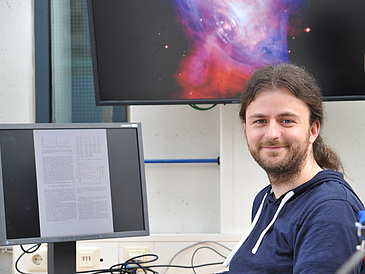Black holes are surprisingly straightforward celestial bodies: They can be characterized simply on the basis of their mass, their rotation, and their electrical charge. Now Norman Gürlebeck, a researcher at the University of Bremen’s Centre of Applied Space Technology and Microgravity (ZARM), has managed to prove the amazing simplicity of black holes in complex astrophysical situations. He has published his findings in the April edition of the journal Physical Review Letters. High expectations are being attached to his discovery: With the aid of gravitation waves and tests involving basic principles of gravitation theory, it supplies direct proof of the existence of black holes.
Black holes signify the final stage in the evolution of a star. They are formed when a star‘s gravitational pull compacts its mass. This only happens though to stars that have at least double the sun’s mass. The star’s gravitational pull is so strong that it gradually becomes increasingly compacted in the process of its evolution. By way of explanation: The necessary extent of compaction is so great that the entire mass of the Earth would be compacted to the size of a hazelnut. The immensely strong gravitational pull of the extremely compacted mass of the black hole leads to a situation in which neither matter nor light can escape from it – which is how it gets the name of black hole.
Three characteristic parameters
Nevertheless, it is possible to completely characterize a black hole externally on the basis of just three parameters: Mass, rotation, and electrical charge. The absence of further characteristics once led John Archibald Wheeler to remark: “Black holes have no hair”. Until now, this characteristic could only be proved under idealized conditions in which the black hole is alone in the universe and there are no other stars at all. Such an assumption can subsequently not hold for black holes that exist in systems with other objects, for example in binary systems which generally consist of a black hole and a star, two black holes or two stars. The gravitational field of the object accompanying a black hole in a binary system would lead to a deformity of the black hole – something like the tides on Earth, which are caused by the Moon’s gravitational pull. Does such a deformity mean that the black hole has to be described by additional parameters – that it now has hair?
Findings are the basis for interpreting gravitational waves
Several international research teams have been attempting to find out. They found initial indications that this is not the case. Now Norman Gürlebeck from the University of Bremen’s ZARM institute has managed to show irrevocably that despite deformation of a black hole, no additional parameters whatsoever are necessary. The renowned journal Physical Review Letters has published this groundbreaking result which, incidentally, also has a practical application. The new findings provide gravitation physicists with an important basis for interpreting the gravitational waves that occur primarily in binary systems. They show that it is possible to prove the existence of black holes in binary systems via analysis of such gravitational waves. In addition to this, the so-called “no hair” characteristic makes it possible to test gravitation theories for strong gravitational waves.
If you would like to have more information on this topic, please contact:
Norman Gürlebeck
Center of Applied Space Technoloogy and Microgravitation (ZARM), University of Bremen
Email: norman.guerlebeckprotect me ?!zarm.uni-bremenprotect me ?!.de
Phone: +49 421 218-57857
For general press inquiries and photos, please contact:
Birgit Kinkeldey
Email: birgit.kinkeldeyprotect me ?!zarm.uni-bremenprotect me ?!.de
Phone: +49 421 218-57755

